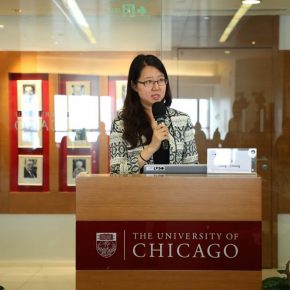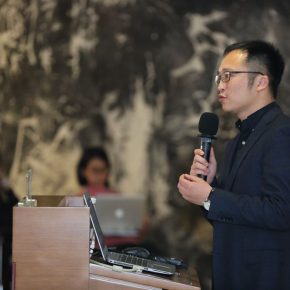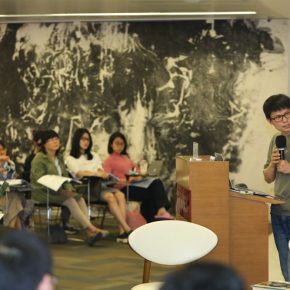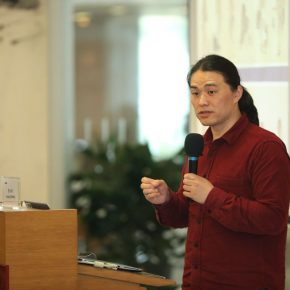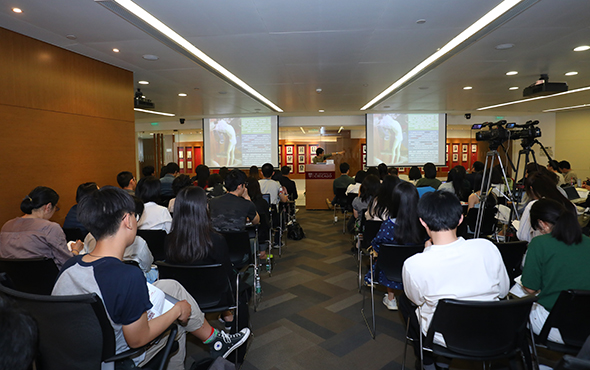
The OCAT Institute initiated the “annual lecture” program, which launched a successive series of academic activities such as seminars, exhibitions, publications, special lectures and relevant workshops with a nominated scholar each year. A comprehensive and in-depth discussion was conducted with the invited scholars’ on their main academic arguments as well as their related research fields. In 2018, the OCAT Institute invited W.J.T. Mitchell, a professor from the University of Chicago, as the leading lecturer. A series of academic workshops and seminars centered on him were also initiated. On April 29, 2018, the first seminar workshop run by W.J.T. Mitchell, “Words and Images” was launched at the U-Chicago Center in Beijing. Five scholars: Bao Huiyi, Chen Yan, Gao Ming, Huang Xiaofeng and Zhuge Yi showed their research on the topic of images, texts, terminology, inscriptions, etc.
The relationship between words and images has always been a hot topic in Eastern and Western aesthetics studies. Aristotle once discussed the correspondent relationships between poetry and painting. Horace, an ancient Roman writer, summarized in his The Art of Poetry that “ut pictura poesis (as is painting so is poetry)” which also affects centuries of research. The emphasis on poetry and painting has always been a topic for debate among Western scholars. A German aesthetician, Lessing, classified them as art of time and art of space in Laocoon. He strove to maintain the boundary between the two, and used a “comparative” method to rationally explore the respective strengths of the two. In the second half of the 20th century, “words and images” have increasingly become a hot topic in the study of contemporary art within critical studies, with scholars such as Michael Fried, Norman Bryson, W.J.T. Mitchell and others from literary critical studies entering the field of art history. “Words and images” thus are no longer confined to a simple distinction between “talking and seeing” and “telling and showing.” As an inherent boundary between language representation and visual representation, it also links with art history, semiotics, linguistics, and other disciplines, as each of them converges, comprises and changes in relative/comparative situations.
Considering the context of Chinese art history, the integration of poetry, calligraphy, and painting is one of the basic characteristics of ancient paintings. “Appreciating Mojie’s poetry, there are paintings in it, observing Mojie’s paintings, there is poetry in it,” Wang Wei’s paintings were highly praised by literati painters. Zhang Yanyuan put forward the theory that “calligraphy and painting are of the same origin” in the Record of Famous Painters of the Past, which built an important framework for traditional Chinese painting and calligraphy theory, it not only points out the common features of traditional Chinese characters and paintings in origin, but also suggests the similarities in practicing both of them. If one considers kanji’s ideographic characters as a system of signs, then the significance of creating calligraphy gives a richer level to the signs’ movements as an independent aesthetic taste. The written words, also get rid of a dependency on the images, but as a way of echoing with images, together being an organic part of painting composition and artistic conception.
Therefore, in this seminar, the themed talks about some “words and images” relation case studies from both Western and Eastern art history. Bao Huiyi’s research focuses on the images of monkeys, dogs, and pigs collected in the fables of Britain in the late Middle Ages. Painted animal fables, integrating the functions of natural history, species origin, moral exegesis, and morality, become a medium for understanding medieval knowledge. It also affects the portrayal of animals in other medieval books. Bao Huiyi’s research is based on the No. 764 animal fable manuscripts from the Oxford Bodleian Library. Combined with the images in the page margins of 13-14th-century British manuscripts “Lateru Poetry Collections,” Bao analyzed three species: monkeys, dogs and pigs with their interactions between graphics and texts, and further explored their representations of the spiritual worlds. Chen Yan’s research also started from the medium of a book, in which Chen focused on the unique edition of “Huizhen Graph” in Romance of the Western Chamber of the late Ming Dynasty (edition collected in Germany). In this set of printing images, the engraved scholar Qi Qilu recorded the “Gengchenqiuri” (Gengchen time Autumn Day) in the format of a fan. This might not only indicate the time of publication of the entire “True Six Magic Huizhen," but also imply the time of the story of “The West Chamber” as well as commemorating the sixty-one year old (yuanming nian) of Qi Qilu himself. This is not the first case of borrowing time as a commemoration in ancient Chinese art works. From the perspective of creators and inquisitors, the time is an inspiration for the artist as well as an important link to the great artworks of ancient times.
Gao Ming focused on the research of traditional art history terminology. In the talk, he summarized and analyzed the terminology within Italian art historian Longhi's book “Francesca.” Using research methods of Vasari to systematically examine the art of the book, and compare vocabulary with the images, Gao reveals the language traditions in the study of art history that is often masked by the research of the “science of art” and “context”. Based on this, he discussed how to use terminology at that time to describe the art in that time. Huang Xiaofeng focuses on the study of ancient Chinese painting. He starts from Li Song’s “Skeleton Magic Show Graph (骷髏幻戲圖)” and Zhou Chen’s “Migrant of Floating People(流民圖)” and explores the problems of reading especially reading ancient paintings from the provided textual information such as question titles and inscriptions. He also finds an interesting interaction between the images and texts. Zhuge Yi’s research returns to W.J.T. Mitchell, as he describes the different perceptions of contemporary words and images and the relation between W.J.T. Mitchell and a French aesthetician, Lancey. Considering the countless comments on practical language, W.J.T.Mitchell tried to construct a new pictorial theory that went beyond the traditional comparative method to study the meaning of paintings. Instead, the images and text as a whole are a “heterogeneous picture” and thus help the visual image get rid of the control of discourse.
The present session of “Words and Images" is just the prelude to the 2018 annual lecture. InSeptember, Professor W.J.T. Mitchell will hold three series of lectures in Beijing on the theme of “Meta-Picture: Images and Theoretical Discourse.” The overall theme of this year’s academic activities is “The Study of Art Theory and Visual Culture.”
About Professor W.J.T Mitchell
W.J.T. Mitchell was born in 1942. He graduated from Michigan State University in the United States and received his Ph.D. in English Literature from Johns Hopkins University in 1968. He then taught in the English department of Ohio State University for the next ten years. In 1977, W. J. T. Mitchell was nominated as Gaylord Donnelley Distinguished Service Professor of English and Art History at the University of Chicago. Professor Mitchell has received fellowships from the Guggenheim Foundation and the National Endowment for the Humanities. In 2017, he was elected to the American Academy of Arts and Sciences.
As a famous art critic and theoretician, Professor Mitchell’s research focuses on literature, visual arts, media history and theory from the 18th century to present and he is especially dedicated to exploring the interplay of vision and language in art. In 1992, W. J. T. Mitchell published “The Pictorial Turn,” in Artforum, in which he endorsed Richard Rorty’s “the Linguistic Turn” and argued for a "pictorial turn" in the humanities, registering a renewed interest in and prevalence of pictures and images. As a pioneer scholar of advanced humanistic studies in an image-oriented manner, he then published the book Picture Theory (1994) in which Mitchell gave a detailed account of his studies, and it is also in this monograph that Mitchell states the famous theory — “Meta-Pictures”. With Iconology: Image, Text, Ideology (1986) and What Do Pictures Want? (2005) published afterward, Mitchell has constructed an academic framework for the pictorial theory and visual culture studies.
In addition, Mitchell has been the editor of Critical Inquiry since 1978. During his 40 year editorship, Critical Inquiry has been recognized for “one of the best known and most influential journals in the world” (Chicago Tribune) and “academe’s most prestigious theory journal” (New York Times) with its published articles covering multiple themes including public arts, psychoanalysis, pluralism, feminism, race and identity, narration, interpretive politics and post-colonialism.
Text by OCAT Institute, translated by Yao Yue and edited by Sue/CAFA ART INFO




